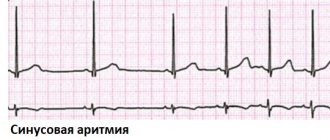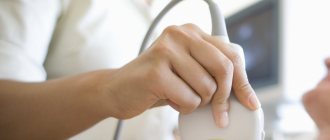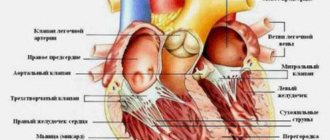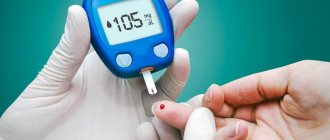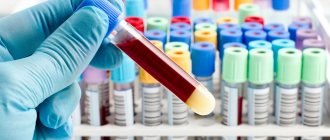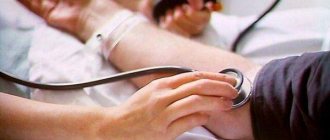Published: 08/13/2021 10:52:00 Updated: 08/13/2021
Hypoglycemia refers to a decrease in blood glucose levels to critical values. This is a dangerous condition that leads to disruption of the brain’s internal organs, and in a severe stage – to irreparable consequences or death due to hypoglycemic coma.
The symptoms of this condition are varied and depend on the cause of the pathology and the characteristics of the individual patient. Timely diagnosis and control of sugar concentrations make it possible to prevent serious complications and maintain the usual way of life.
Causes of fasting glycemia
One of the main causes of disease in adults is insulinoma. These are tumors that can arise on their own or be part of endocrine adenomatosis (pancreatic tumor).
The disease can develop against the background of acute liver diseases, which include liver cirrhosis, hematoma and others.
The disease can begin to develop due to changes in the usual lifestyle: increased physical activity, adherence to all kinds of diets. The cause may be increased weight.
In children, the causes of fasting glycemia may be congenital liver failure. The disease can also be provoked by congenital disorders of fatty acid oxidation and disorders of ketogenesis.
Triple therapy for type 2 diabetes
If two-component therapy is ineffective, another, third hypoglycemic drug is added within 2-3 months. It could be:
- an oral drug belonging to a different class of hypoglycemic agents than the first two components of the treatment regimen;
- insulin;
- injectable exenatide.
Drugs from the thiazolidinedione group are not recommended as a third drug in the regimen. Thus, data from the American Endocrinology Association indicate an increased risk of myocardial infarction in patients taking roxiglitazone. Therefore, it is recommended to be prescribed only to those patients who cannot control their glucose levels with other drugs.
In patients at high risk for cardiovascular disease, reducing HbA1c levels to 6% or below may increase the risk of cardiovascular disease. Thus, an observation of a group of 44,628 patients conducted by American scientists led by Danielle C. Colayco showed that patients with an HbA1c level of less than 6% had cardiovascular problems 20% more often than patients with an average HbA1c level 6–8%.
Published in Diabetes Care, 2011
An experiment conducted by the ACCORD (Action to Control Cardiovascular Risk in Diabetes) research group showed that a drop in HbAc1 levels below 6% in patients at risk led to an increase in five-year mortality from myocardial infarction.
Data from researchers led by Gerstein HC, published in The new England journal of medicine, 2011
Another well-known thiazolidinedione, pioglitazone, has also received alarming information about an increased risk of developing bladder cancer with its use. The American Drug Regulatory Association (FDA) does not recommend prescribing pioglitazone to patients with a history of bladder cancer.
GLP1 receptor agonists have a different mechanism of action from other hypoglycemic drugs. They mimic endogenous incretin GLP-1 and thus stimulate glucose-dependent insulin release. In addition, GLP1 receptor agonists help reduce glucagon levels.
The combination of exenatide, the best-known drug in this group, with one or two oral medications (for example, metformin and/or sulfonylureas) is attractive for its simplicity and high effectiveness.
Treatment of fasting glycemia
If you have been diagnosed with fasting glycemia, there is no need to panic. You can start treatment without leaving your home. To do this, you need to take 15 grams of carbohydrate or 120 grams of unsweetened fruit juice. This is the so-called simple form of carbohydrate. It is found in non-alcoholic diet drinks.
If the disease begins to progress to a more severe form, it is recommended to increase the dose of carbohydrate intake to 20 grams. After some time, take an additional dose of complex carbohydrate (20 g): bread or dry cookies.
If the disease has caused the patient to lose consciousness, it is necessary to place a piece of sugar, a small handful of honey or glucose gel on his cheek. If you have the drug “Glucagon” at home, it is necessary to administer it intravenously to the victim. You can also use Dextrose. This drug is more effective and helps to quickly increase blood glucose levels and return the patient to consciousness.
Metformin
Metformin is the drug of choice for monotherapy, as well as the leading drug in combination treatment for type 2 diabetes mellitus. Its advantages include:
- efficiency;
- no weight gain;
- low likelihood of hypoglycemia;
- low level of side effects;
- good tolerance;
- low cost.
Scheme 1. List of hypoglycemic drugs used for type 2 diabetes mellitus
The dose of metformin is titrated over 1–2 months, determining the most effective method of selection. The therapeutically active dosage is at least 2000 mg of metformin per day. To reduce the risk of side effects from the gastrointestinal tract, the drug is taken during or after meals several times a day.
Metformin reduces the risk of developing dementia associated with type 2 diabetes. This was proven in a large 2013 study involving 14,891 patients divided into four groups depending on which drug they took. Throughout the experiment, patients received monotherapy with metformin, sulfonylureas, thiazolidinediones and insulins. Within five years after starting metformin treatment, dementia was diagnosed in 1487 (9%) patients. This is 20% lower than the sulfonylurea group and 23% lower than the thiazolidinediones group (data from Colayco DC, et al., Diabetes Care, 2011).
Prevention of fasting glycemia
If among your relatives there are patients susceptible to glycemia due to changes in blood sugar levels, you need to constantly remind them of the need to take medications and to avoid overdose. Patients with glycemia should consult a doctor for advice. The doctor must explain in clear language how to independently test for blood glucose levels, when and in what volume to take the appropriate medications.
Every person with glycemia should understand that before getting behind the wheel, they should check their blood sugar levels. If it turns out to be below normal, then you cannot drive a car without taking the required amount of carbohydrates.
Pharmacotherapy for type 2 diabetes
Early initiation of pharmacotherapy for type 2 diabetes helps improve glycemic control and reduces the likelihood of long-term complications. As for the question of how to treat type 2 diabetes and what specific drugs to use, everything will depend on the chosen treatment regimen.
Diabetes mellitus type 2 (DM 2) is characterized by hyperglycemia, which develops as a result of a combination of disorders, including:
- tissue insulin resistance;
- insufficient secretion of insulin;
- excessive or inadequate secretion of glucagon.
Poorly controlled type 2 diabetes is associated with microvascular and neuropathic complications. The main goal of treatment for patients with type 2 diabetes is to eliminate symptoms and prevent or at least prolong the development of complications.
Lectures DM1
The main chronic complications of type 1 diabetes, the mechanism of their development, clinical manifestations, measures to prevent the development of chronic complications, early diagnosis.
Fig.1
IN WHICH ORGANS DO COMPLICATIONS OF DIABETES DEVELOP?
Diabetes mellitus, if poorly controlled, can lead to adverse consequences: due to increased levels of glucose in the blood, diabetes-specific complications in the eyes, kidneys, and legs gradually arise and progress very quickly. And the “insidiousness” of diabetes is that these complications appear 10-15 years after the onset of the disease, develop unnoticed and at first do not affect your well-being. Unfortunately, it can be very difficult to cope with complications that have already manifested themselves. Therefore, diabetes must be well controlled from the very beginning of the disease. If some initial manifestations of complications have appeared, then improved control will help prevent them from developing. Small vessels in the eyes and kidneys are affected - this is called microangiopathy. The walls of small vessels, being in constant contact with the blood flowing inside the vessels, are very sensitive to increased glucose levels. Under its influence, irreversible changes gradually occur in the vascular wall, as a result of which the blood supply, and therefore the nutrition of the entire organ, deteriorates. This, in turn, leads to disruption of its operation.
EYE DAMAGE. DIABETIC RETINOPATHY
Fig.2
In the eyes, against the background of constantly elevated blood glucose levels, the retina is affected. The retina lines the inside of the eyeball.
The basis of the retina is a plexus of small vessels; it also contains nerve endings that provide vision function. A complication of diabetes caused by changes in the blood vessels of the retina is called diabetic retinopathy (the word comes from the Latin name for the retina - retina, which means “network”).
The meaning of the frequently used term “fundus” should also be explained. This is the name for the part of the inner lining of the eye that is visible during a special examination performed by an ophthalmologist, i.e. retina. So, the cause of diabetic retinopathy is long-term decompensation of diabetes. In diabetic retinopathy, retinal vessels become more fragile, permeable, and lose elasticity, which leads to the development of microaneurysms - protrusions on the vessels, and then to hemorrhages. Diabetic retinopathy develops gradually, and even quite pronounced stages may be imperceptible to a person. In other words, if a diabetic patient does not complain of decreased vision, this does not mean that he does not have retinopathy! With further development of the process, new formation of retinal vessels may occur, followed by massive hemorrhages (this is called proliferative retinopathy). In this case, a significant decrease in visual acuity may occur. The presence and severity of this complication of diabetes can only be determined by an ophthalmologist (ophthalmologist) by examining the fundus of the eye with a dilated pupil. To dilate the pupil, special drops are instilled into the eyes, after which vision temporarily becomes blurry and unclear. This procedure is necessary, since sometimes in diabetic retinopathy the main changes are located on the periphery of the retina, while in the central zone, which is visible without dilating the pupil, they are not yet present. An ophthalmologist examines the fundus using a special device.
If there is a noticeable deterioration in vision, you can choose glasses from an ophthalmologist. However, it is not possible to improve vision affected by retinopathy with glasses. The same changes that can be corrected by choosing glasses are not associated with retinopathy, although they sometimes cause unreasonably strong anxiety for the patient, since he attributes them to complications of diabetes.
Every person with diabetes should visit an ophthalmologist at least once a year.
If retinopathy is present, the frequency of examinations should increase (how often is decided by the ophthalmologist), since at some point treatment may be necessary. Immediate examination should be carried out if there is a sudden deterioration in vision.
PREVENTION AND TREATMENT OF DIABETIC RETINOPATHY
The basis for the prevention of retinopathy, as well as all complications of diabetes, is maintaining good diabetes compensation, i.e. maintaining blood glucose levels as close to normal as possible. Regular eye examinations are extremely important, as discussed above.
It should also be noted that the condition of the fundus of the eye is negatively affected by disorders such as high blood pressure, blood cholesterol, and smoking. To preserve vision, it is important that these indicators are monitored and maintained within normal limits. The level of total cholesterol (it must be determined at least once a year) should be below 5.2 mmol/l (according to the latest data, below 4.5 mmol/l); Blood pressure levels will be discussed in the section on kidney damage.
You should not rely on unproven methods of treatment - advertisements for some “magic” plants, etc. appear from time to time. Currently, there are no effective medications for the treatment and prevention of diabetic eye damage.
A reliable method of treating diabetic retinopathy, recognized and successfully used throughout the world, is laser coagulation of the retina. Timely and correctly performed laser coagulation allows you to preserve vision even in the later stages of diabetic retinopathy. However, treatment is most effective in the early stages of retinopathy.
Laser photocoagulation is an outpatient procedure that is performed in one or more sessions and is completely safe. Its meaning is to use a laser beam to influence the altered retina, which helps prevent further progression of the process. It should be understood that this type of treatment only stops the further development of diabetic retinopathy, but if there is already a significant decrease in vision, there is no return to completely good vision. This is why it is so important to carry out laser coagulation in the early stages, when vision has not yet been reduced.
A prerequisite for a lasting positive effect from laser photocoagulation is good compensation of diabetes; in its absence, the progression of retinopathy will continue.
In severe proliferative diabetic retinopathy in the case of severe hemorrhages in the vitreous body (hemorrhages are an obstacle to light and also threaten retinal detachment), the use of surgical treatment methods is necessary. A so-called vitrectomy is performed - removal of the vitreous body. To avoid acute situations (massive hemorrhages, retinal detachment), which can lead to irreparable consequences, you need to avoid heavy physical activity. Heavy lifting is dangerous, as is severe straining, which can occur with constipation or a persistent cough.
CATARACT
Fig.3
In diabetes mellitus, along with retinal damage, clouding of the lens, which is called cataracts, often occurs. This disease is also common among people who do not have diabetes, especially in older age groups.
If the clouding of the lens is severe, the penetration of light rays to the retina is difficult and vision deteriorates significantly, up to its complete loss. The treatment of cataracts is now well established; a radical method is surgery to remove the clouded lens. Vision is restored after such an operation, although it requires correction with glasses or by replacing the removed lens with an artificial one. It is important for a diabetic patient to know that any operations, including lens removal, proceed successfully only against the background of good compensation for diabetes. This condition is also put forward by ophthalmological surgeons.
KIDNEY DAMAGE. DIABETIC NEPHROPATHY
Fig.4
Against the background of long-term decompensation of diabetes in the kidneys, small vessels are affected, which are the main part of the renal glomerulus (kidney tissue consists of many such glomeruli). The vessels of the renal glomerulus provide the function of the kidneys, which act as a filter in the human body. The kidneys excrete unnecessary substances in the urine, filtering them from the blood; necessary substances are retained, sending them back into the blood.
When, due to an increased level of glucose in the blood, the vessels of the renal glomeruli change, the normal functioning of the renal filter is disrupted and protein, which is a necessary substance and does not normally enter the urine, begins to penetrate there.
A complication of diabetes caused by damage to blood vessels in the kidneys is called diabetic nephropathy. In the early stages, its development cannot be felt in any way.
Every diabetic patient must undergo a urine test at least once a year to determine the protein in it.
This can be a regular, so-called general urine test, which is done in any clinic. However, diabetic nephropathy can be detected at earlier stages, which is very important for therapeutic and preventive measures. This is a urine test for microalbuminuria, i.e. micro amounts of albumin protein. Daily urine is collected: the norm is the excretion of up to 30 mg of protein per day, micro albuminuria - from 30 to 300 mg, proteinuria - more than 300 mg. By the way, the appearance of protein in the urine does not always indicate diabetic nephropathy. This may also be a manifestation of the inflammatory process in the kidneys, for example, an exacerbation of chronic pyelonephritis. At the same time, there will be other changes in the urine.
INCREASED BLOOD PRESSURE
Fig.5
Elevated blood pressure levels are not always accompanied by some unpleasant sensations. The danger of increased blood pressure is that it itself causes serious harm to the kidneys, i.e. a kind of vicious circle develops: high blood glucose levels → kidney damage → increased blood pressure → kidney damage → increased blood pressure.
Therefore, elevated blood pressure levels, regardless of the causes, must be reduced. The maximum permissible level is currently considered to be 140 mmHg. Art. - for the upper indicator (systolic blood pressure) and 85 mm Hg. Art. - for lower (diastolic blood pressure). If at least one of these two indicators is often above the specified limits, treatment is necessary.
PREVENTION AND TREATMENT OF DIABETIC NEPHROPATHY
As with diabetic retinopathy, prevention and treatment of diabetic nephropathy primarily includes compensation for diabetes mellitus, i.e. maintaining blood glucose levels as close to normal as possible. If a persistent increase in blood pressure is registered, the doctor will prescribe appropriate treatment. There are now a lot of medications for the treatment of arterial hypertension, and effective treatment can be selected for every diabetic patient. It is important for the patient to understand that these medications must be taken constantly, i.e. not only with high blood pressure, but also with blood pressure that has dropped to normal, so that it does not increase! In this case, an obligatory component of treatment will be independent monitoring of blood pressure at home, in particular to assess the effectiveness of the drugs used, therefore all people with arterial hypertension need to have a device for measuring blood pressure (tonometer) at home and be able to use it.
It is necessary to measure blood pressure daily in the morning and evening, recording the data obtained in a self-monitoring diary for discussion with a doctor and selection of treatment. Recently, even in the presence of microalbuminuria (even without an increase in blood pressure), drugs are prescribed that, in principle, are intended to lower blood pressure (the so-called ACE inhibitors), but in this case are used to protect the kidney from further damage.
An important factor in the treatment of hypertension is limiting table salt to 3-5 g per day (it should be remembered that 1 teaspoon contains 5 g of salt). This involves excluding foods rich in salt from the diet (pickled cucumbers and tomatoes, sauerkraut, pickled mushrooms, herring, mineral water high in sodium, etc.). All canned foods tend to contain a lot of salt. Food should be prepared from natural products without adding salt. Don't be afraid to limit your salt! A healthy body requires only 0.5 g of salt per day, and we often eat up to 10-15 g.
If diabetic nephropathy reaches advanced stages, the doctor may recommend a special diet with limited protein (this mainly applies to animal products - meat, fish, eggs, cheese, cottage cheese, etc.). If renal failure develops (an indicator of this will be an increase in the level of creatinine in a biochemical blood test, it also needs to be determined for all patients with diabetes at least once a year), hemodialysis (artificial kidney) or a kidney transplant is used.
LEGS IMPAIRMENT
Fig.6
Why are the legs one of the most vulnerable parts of the body with diabetes? The fact is that the legs are affected by a number of external factors: walking, body weight, shoes. In diabetes mellitus, these factors can include damage to nerves, blood vessels, and impaired ability to heal wounds.
Young people with type 1 diabetes primarily experience nerve damage called diabetic polyneuropathy, which is associated with long-term high blood glucose levels. At a more mature age, damage to large vessels is also possible, which is a manifestation of atherosclerosis and is often associated with an increase in such indicators as cholesterol levels in the blood. However, elevated blood glucose levels aggravate the severity of the atherosclerotic process.
Manifestations of diabetic neuropathy include various types of pain in the legs, a burning sensation, “crawling sensations,” tingling, and numbness. These symptoms can be very painful, but there is another danger that is not always noticeable to a diabetic patient. Neuropathy is characterized by a decrease in the sensitivity of the legs: the ability to perceive the effects of high and low temperatures, pain (for example, a prick with a sharp object), etc., is lost. This poses a great danger because it increases the risk and makes minor injuries invisible, for example, when foreign objects get into shoes, wearing incorrectly selected shoes, when treating nails, calluses.
Decreased sensitivity combined with foot deformities common in diabetes leads to improper distribution of pressure when walking. This leads to trauma to the tissues of the foot, up to the formation of ulcers in areas of greatest stress. The so-called diabetic foot syndrome occurs. Areas of trauma can become inflamed and infection develops. The inflammatory process in conditions of reduced sensitivity occurs without pain, which can lead to underestimation of the danger. Self-healing does not occur if diabetes compensation is unsatisfactory, and in severe advanced cases the process can progress, leading to the development of purulent inflammation - phlegmon.
In the worst case scenario and in the absence of treatment, tissue necrosis - gangrene - can occur. A sign of damage to large arteries and impaired blood supply at severe stages is pain in the legs when walking. They occur in the lower legs even after walking for a short time, and the person must stop and wait until the pain goes away before continuing on. This pattern is called “intermittent claudication.” Coldness of the feet may also be a concern.
PREVENTION AND TREATMENT OF LEG LESIONS
Since diabetic feet are at such great risk, every diabetic patient should be familiar with measures to prevent the complications described above. First of all, this is a good compensation for diabetes; it cannot be replaced by any other preventive and therapeutic purposes, including medications! In addition, you need to stop smoking and monitor your blood pressure and cholesterol levels.
It is advisable to undergo a medical examination of your feet at least once a year (with determination of various types of sensitivity and pulsation in the arteries of the feet)
Examination of the feet is best done in a specialized office “Diabetic foot” - there are more and more such offices in our country in recent years. In addition, every diabetic patient should be familiar with a set of preventive measures to reduce the risk of leg damage. Preventive measures can be presented in the form of “prohibiting” and “permitting” rules, which we present below.
FOOT CARE RULES
Fig.7
This cannot be done if you have diabetes!
First of all, you should not use any sharp objects when caring for your feet: scissors, callus knives, razor blades. The use of such objects is one of the most common causes of injury, especially in conditions of reduced sensitivity and poor vision! In the absence of these “risk factors”, using scissors is possible, but you should not cut your nails too short and cut the corners too deep. This can lead to the formation of a so-called ingrown nail - the cause of pain, inflammation and long-term treatment, including surgery. Wearing tight shoes also contributes to ingrown toenails.
If your feet are cold, you cannot warm them with heating pads (including electric ones), steam heating radiators, or electric heating devices. Temperature sensitivity in a diabetic patient is often reduced, so it is easy to get burned.
For the same reason, you should not take hot foot baths. The water temperature should not be higher than 37 °C (it is better to measure it with a water thermometer, as for bathing children). In addition, foot baths should not be long - this loosens the skin and makes it more vulnerable.
It is not recommended to walk without shoes, as there is a high risk of injury with simultaneous penetration of infection into the area of injury. You must wear bathing slippers on the beach and when swimming. You should also protect your feet from sunburn.
It is necessary to avoid uncomfortable (narrow, chafing, pressing) shoes and not to wear high-heeled shoes. High heels contribute to poor circulation in the foot and the formation of areas of increased pressure on its plantar surface. You need to be careful with new shoes: wear them for no more than 1 hour for the first time, and also never use any breaking-in methods, such as putting them on a wet sock. An additional risk of injury is created by shoes that open and therefore do not protect the toes and heel. Sandals or sandals with a strap that goes between the toes can injure the delicate skin in this area. It is unacceptable to wear shoes on bare feet due to the high likelihood of abrasions.
If you have calluses on your feet, you should not try to get rid of them with callus fluids, ointments or patches, as they all contain substances that corrode the skin. Calluses usually form as a result of wearing ill-fitting shoes that put pressure on the foot in certain places.
You should pay attention to the elastic bands of your socks. If they are too tight and leave indentations on the skin of the shins, it impedes blood circulation.
This is how you need to take care of your feet if you have diabetes!
Every day, a diabetic patient should carefully examine his feet, especially the plantar surface, heel area and interdigital spaces. Older people and overweight people may experience considerable difficulty with this. They may be advised to use a mirror placed on the floor during the examination, or ask relatives to do this, especially if their vision is impaired. Daily inspection allows you to promptly detect wounds, cracks, and abrasions.
It is necessary to wash your feet daily. After washing your feet, wipe them dry with a soft towel, especially in the spaces between the toes. High humidity in these areas contributes to the development of diaper rash and fungal diseases. For the same reason, when using a moisturizer for excessively dry skin, you should not apply it between your fingers.
Nails should be treated regularly (at least once a week) using a file. This will not only avoid injury, but also form the correct horizontal edge of the nail, leaving its corners untouched.
The most suitable remedy for removing calluses and areas of excessive keratinization (thickening and dryness) of the skin is pumice. It is better to buy a special pumice stone for foot care at the pharmacy. You should use it while washing your feet and do not try to get all problem areas in complete order in one go.
If your feet are cold, you need to warm them up with warm socks of the appropriate size and without tight elastic bands. It is necessary to ensure that the socks do not bunch up in the shoes.
You should make it a rule to check the inside surface of your shoes before putting them on: whether any foreign objects have gotten inside, whether the insole is curled up, or whether sharp nails are showing through. Let us remind you once again that this is necessary due to the fact that the sensitivity of the feet can be reduced, which the person with diabetes is not aware of.
Your feet are protected when you wear the right shoes. If necessary, advice on choosing shoes can be obtained from the Diabetic Foot office.
FIRST AID FOR FOOT INJURIES
Even minor injuries to the feet should be shown to a doctor, but a person should be able to provide first aid to himself. If, when examining your feet, a wound, abrasion or crack is discovered, you need to wash it with a disinfectant solution. You can use a 1% solution of dioxidin, 0.01% solution of miramistin or 0.02% solution of furatsilin. The washed wound should be covered with a sterile bandage or bactericidal patch. You cannot use a regular adhesive plaster!
All of the above products must be in your home first aid kit, and also taken with you on trips. Do not use alcohol solutions (alcohol solution of iodine, brilliant green - brilliant green), as well as a concentrated, dark solution of potassium permanganate (potassium permanganate). They can cause burns and also stain the skin, preventing signs of developing inflammation from being seen. It is also undesirable to use oil dressings (with fat-based ointments), which create an environment for the development of infection and impede the drainage of secretions from the wound. There is no point in treating wounds with insulin; it has no healing effect. If signs of inflammation appear in the area of damage (redness, swelling, purulent discharge), immediate medical attention is needed. The best option would be to contact the Diabetic Foot office. Surgical debridement and antibiotics may be required. In such a situation, it is important to provide complete rest to the leg. The doctor may prescribe bed rest; if ambulation is necessary, use crutches to avoid putting stress on the leg.
CHECK-UPS FOR DIABETES
To summarize this section, I would like to emphasize once again that diabetes complications are preventable. To do this, first of all, regular monitoring of your condition by a diabetic patient is necessary. Let us repeat once again which indicators, in addition to blood glucose levels, need to be regularly monitored, as well as which specialists should be visited.
Glycated hemoglobin (HbA1c) - once every 6 months, if necessary, once every 3 months.
Level of cholesterol in the blood (preferably also other indicators of lipid metabolism), creatinine in the blood - at least once a year.
Blood pressure at every visit to the doctor or on your own at home.
Protein in the urine (microalbuminuria) - at least once a year.
Examination by an ophthalmologist with a dilated pupil - at least once a year.
Medical examination of the feet at least once a year. If problems are detected, more frequent monitoring is required, as well as treatment prescribed by a doctor and carried out with the active participation of the person himself.
The main reason for the development and progression of diabetes complications is long-term decompensation of the disease. In addition to daily self-monitoring of glycemia and blood pressure, and following foot care rules, a diabetic patient must undergo a series of annual examinations
How do symptoms manifest themselves?
Hypoglycemia symptoms begin to appear due to increased activity of the autonomic nervous system. And first of all, a person notices sweating. Further in different combinations there may be:
- nausea and vomiting;
- feeling of hunger;
- headache and weakness;
- drowsiness;
- frequent urination;
- blurred vision;
- lack of coordination;
- fear, panic, hand tremors;
- pallor of the skin.
Are you experiencing symptoms of hypoglycemia?
Only a doctor can accurately diagnose the disease. Don't delay your consultation - call
What are the varieties?
It is worth noting that hypoglycemia itself is not a disease in the classical sense. This is a condition that occurs due to certain factors and accompanies different types of diseases. Most often we are talking about diabetes mellitus. In medical practice, there are several stages of this condition:
- easy (a person can help himself independently);
- medium (requires help from other people);
- severe (the most severe stage, when a person falls into a hypoglycemic coma).
Reasons for the development of hypoglycemic syndrome
For the disease hypoglycemia, the causes lie in skipping meals (with an interval of more than 6 hours). The following items can also cause deterioration in health:
- insufficient amount of carbohydrates in the diet;
- excessive physical activity and stress;
- administration of an increased dose of insulin;
- use of certain types of medications;
- severe emotional stress;
- dehydration of the body.
Prevention of hypoglycemia
Simple and effective recommendations allow the patient to control their condition and live a full life:
- strictly adhere to the diet (healthy diet without long breaks between meals), as well as sleep, exercise, and taking prescribed hypoglycemic and other medications;
- Constantly monitor sugar levels (measurement with a glucometer at home, repeated tests for glycosylated hemoglobin every 3 months);
- learn to clearly identify signs of low glucose levels, always carry sweet bars with you and notify loved ones about first aid measures in case of an attack.
Author:
Pugonina Tatyana Alekseevna, Therapist
What to do?
“If symptoms of hypoglycemia occur and blood sugar drops below 2.8 mmol/l or if blood glucose is detected below 2.2 mmol/l, even without complaints, a quick intake of easily digestible (fast) carbohydrates is necessary,” notes Oksana Dyukareva.
The most suitable products for quickly replenishing blood glucose, says the endocrinologist, are 3-5 teaspoons of sugar, 1.5-2 tablespoons of honey or jam, 100-200 ml of fruit juice or other sugar-containing drinks.
“I recommend telling your loved ones about the possibility of this condition so that they can quickly help you before you lose consciousness. If consciousness is impaired, it is possible to administer 1 mg of glucagon intramuscularly or subcutaneously (purchase is possible at a pharmacy), call a doctor,” advises Oksana Dyukareva.
With timely elimination of hypoglycemia, the prognosis is favorable, warns the endocrinologist. But it is always better to prevent this condition. From the first day of diagnosis of diabetes, you should always keep fast carbohydrates with you in sufficient quantities. Also, a person with such a diagnosis should carefully monitor the organization of his diet - one must not forget about timely meals. In addition, you should monitor your blood sugar with a glucometer. And also, advises Oksana Dyukareva, it is necessary to plan sports activities, as well as other physical activity that may require additional energy expenditure - it is important that the body has enough reserves to support such tasks. And, of course, it is always necessary to discuss treatment methods and the possibility of hypoglycemia while taking your glucose-lowering medications with your doctor.
Treatment of hypoglycemia
First of all, when signs of this condition appear, it is necessary to provide the body with glucose.
Conscious patients should be given quickly digestible carbohydrates: sweet drinks (fruit juice, compote, tea, sweetened water) and sweets (sweets, marmalade, honey, pure sugar). In cases of moderate severity, a glucose/dextrose solution is administered intravenously and/or subcutaneously, glucagon is administered subcutaneously or intramuscularly.
For hypoglycemic coma, droppers with saline, insulin and electrolytes are used.
First of all, medical care for hypoglycemia is aimed at treating the underlying disease that caused the pathology.
Diagnosis of hypoglycemia
The signs of this condition are quite characteristic, and the primary diagnosis is most likely made after a conversation with the patient and his examination.
The only difficulty is finding out the true cause of this pathology. Therefore, a wide range of laboratory and instrumental examination methods are used for diagnosis. First of all, if hypoglycemia is suspected, a blood test is performed to check the sugar level, which in this condition drops below 3.5 mmol/l. This test may produce biased results because many factors, including time of day, affect sugar concentrations.
The determination of glycosylated hemoglobin (HBA1c) is of great diagnostic importance. This is a stable combination of hemoglobin A with glucose in red blood cells: the more glucose in the blood, the higher the level of HBA1c. Throughout the life of a red blood cell (120 days), this compound continues to circulate in the blood, and determining the concentration of HBA1c allows us to reveal the true concentration of glucose over the last two to three months.
In order to establish the cause of hypoglycemia, a blood test is performed for hormones (in particular, the thyroid gland and adrenal glands), the presence of excess alcohol and medications, a urine test, a biopsy of the liver and pancreas to confirm insufficient production of enzymes, ultrasound, MRI and CT scan of internal organs.
